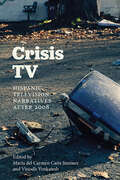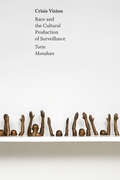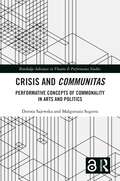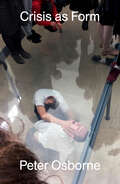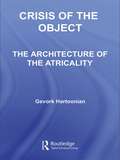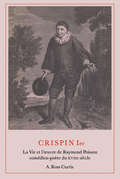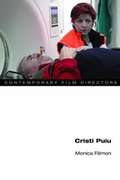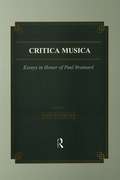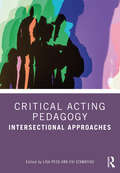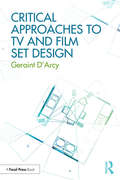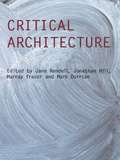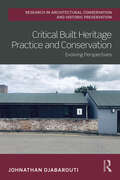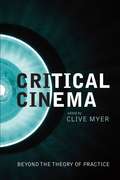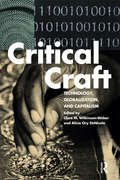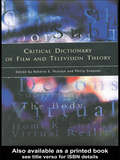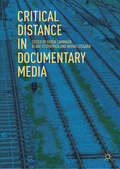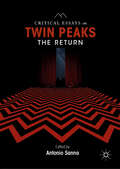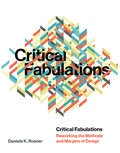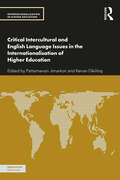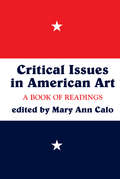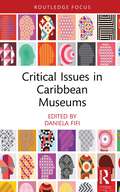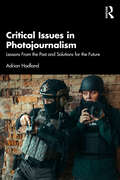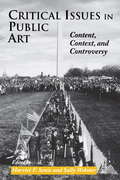- Table View
- List View
Crisis TV: Hispanic Television Narratives after 2008 (SUNY series in Latin American and Iberian Thought and Culture)
by María del Carmen Caña Jiménez; Vinodh VenkateshCrisis TV addresses the motif of crisis that has come to dominate contemporary Hispanic televisual production since 2008 and the onset of the global financial crisis. In almost unprecedented fashion, the global economy came to a standstill, reshaping both geopolitical organizations and, more importantly, the lives of billions across the globe. The Great Recession, sociopolitical instabilities, the rise of extremist political parties and governments, and a worldwide pandemic have resulted in a mode of crisis that pervades contemporary television fiction. 2008 also marks a revolution in television, as local and global streaming services began to gain market share and even overtake traditional over-the-air transmission. The essays in Crisis TV identify and analyze the narrative tropes and aesthetic qualities of Hispanic television post-2008 to understand how different regions and genres have negotiated these intersecting crises and changing dynamics in production, dissemination, and consumption.
Crisis Vision: Race and the Cultural Production of Surveillance (Errantries)
by Torin MonahanIn Crisis Vision, Torin Monahan explores how artists confront the racializing dimensions of contemporary surveillance. He focuses on artists ranging from Kai Wiedenhöfer, Paolo Cirio, and Hank Willis Thomas to Claudia Rankine and Dread Scott, who engage with what he calls crisis vision—the regimes of racializing surveillance that position black and brown bodies as targets for police and state violence. Many artists, Monahan contends, remain invested in frameworks that privilege transparency, universality, and individual responsibility in ways that often occlude racial difference. Other artists, however, disrupt crisis vision by confronting white supremacy and destabilizing hierarchies through the performance of opacity. Whether fostering a recognition of a shared responsibility and complicity for the violence of crisis vision or critiquing how vulnerable groups are constructed and treated globally, these artists emphasize ethical relations between strangers and ask viewers to question their own place within unjust social orders.
Crisis and Capitalism in Contemporary Argentine Cinema
by Joanna PageThere has been a significant surge in recent Argentine cinema, with an explosion in the number of films made in the country since the mid-1990s. Many of these productions have been highly acclaimed by critics in Argentina and elsewhere. What makes this boom all the more extraordinary is its coinciding with a period of severe economic crisis and civil unrest in the nation. Offering the first in-depth English-language study of Argentine fiction films of the late twentieth century and early twenty-first, Joanna Page explains how these productions have registered Argentina's experience of capitalism, neoliberalism, and economic crisis. In different ways, the films selected for discussion testify to the social consequences of growing unemployment, rising crime, marginalization, and the expansion of the informal economy. Page focuses particularly on films associated with New Argentine Cinema, but she also discusses highly experimental films and genre movies that borrow from the conventions of crime thrillers, Westerns, and film noir. She analyzes films that have received wide international recognition alongside others that have rarely been shown outside Argentina. What unites all the films she examines is their attention to shifts in subjectivity provoked by political or economic conditions and events. Page emphasizes the paradoxes arising from the circulation of Argentine films within the same global economy they so often critique, and she argues that while Argentine cinema has been intent on narrating the collapse of the nation-state, it has also contributed to the nation's reconstruction. She brings the films into dialogue with a broader range of issues in contemporary film criticism, including the role of national and transnational film studies, theories of subjectivity and spectatorship, and the relationship between private and public spheres.
Crisis and Communitas: Performative Concepts of Commonality in Arts and Politics (Routledge Advances in Theatre & Performance Studies)
by Małgorzata Sugiera Dorota SajewskaThis book is a critical, transdisciplinary examination of a broad range of philosophical ideas, theoretical concepts, and artistic projects of community in the 20th and 21st century in the context of global/local social and political changes. This volume opens new vitas by focusing on carefully selected instances of multipronged crises in which existing concepts of commonality are questioned, reformulated, or even speculatively designed with a (better) future in view. As many authors of this volume argue, in the face of today’s unprecedented global ecological and economic challenges speculative design is of utmost importance as it can foster alternative, unthought-of forms of connectivity that go far beyond progressivist narratives of nation, corporation, and nuclear family. Focusing on the situations of upheaval, both historical and fabulated, the collection not only examines how multipronged crises trigger antagonisms between egalitarian forms of communitas and the normative concept of the nation (and other normative forms of communities) as a community that separates and excludes. It also looks closely at philosophical and artistic projects that strive to go beyond the dichotomies and typically extrapolated utopias, envisaging new political economies, ways of living and alternative relational structures. It will be of great interest to students and scholars in performance studies, cultural studies, political studies, media studies, postcolonial and decolonial studies, critical anthropology.
Crisis as Form
by Peter OsborneHow does contemporary art best respond to social crisis? Through reflection on its own crisis of formCriticism of contemporary art is split by an opposition between activism and the critical function of form. Yet the deeper, more subterranean terms of art-judgment are largely neglected on both sides. These essays combine a re-examination of the terms of judgement of contemporary art with critical interpretations of individual works and exhibitions by Luis Camnitzer, Marcel Duchamp, Matias Faldbakken, Anne Imhof and Cady Noland. The book moves from philosophical issues, via the lingering shadows of medium-specificity (in photography and art music), and the changing states of museums, to analyses of the peculiar ways that works of art relate to time.To give artistic form to crisis, it is suggested, one needs to understand contemporary art&’s own constitutive crisis of form.
Crisis of the Object: The Architecture of Theatricality
by Gevork HartoonianLooking back over the twentieth century, Hartoonian discusses the work of three major architects: Peter Eisenman, Frank Gehry and Bernard Tschumi, in reference to their theoretical positions and historicizes present architecture in the context of the ongoing secularization of the myths surrounding the traditions of nineteenth century architecture in general, and, in particular, Gottfried Semper's discourse on the tectonic. Providing a valuable contribution to the current debates surrounding architectural history and theory, this passionately written book makes valuable reading for any architect.
Crispien Ier: La Vie et l'œuvre de Raymond Poisson comédien-poète du XVIIe siècle
by A. Ross CurtisRaymond Poisson, a contemporary of Molière, was the leading comic actor with the troupe of the Hôtel de Bourgogne and later at the Comédie Française during the first five years of its existence. He popularized one of the French stage's best-loved stock characters, the impudent servant Crispin, while finding time to supply his troupe with short comedies in which he himself starred. This study is thoroughly documented and reflects the author's detailed knowledge of, and interest in, the period. It establishes Poisson's place in theatrical history, and illuminates a whole tradition in French theatre in the seventeenth century.
Cristi Puiu (Contemporary Film Directors)
by Monica FilimonCristi Puiu's black comedy The Death of Mr. Lazarescu announced the arrival of the New Romanian Cinema as a force on the film world stage. As critics and festival audiences embraced the new movement, Puiu emerged as its lodestar and critical voice. Monica Filimon explores the works of an artist dedicated to truth not as an abstract concept, but as the ephemeral revelation of the fuller, ungraspable world beyond the screen. Puiu's innovative use of the handheld camera as an observer and his reliance on austere, restricted narration highlight the very limits of human understanding, guiding the viewer's intellectual and emotional sensibilities to the reality that has been left unfilmed. Filimon examines the director's ethics of epiphany not only in relation to the collective and personal histories that have triggered it, but also in dialogue with the films, texts, and filmmakers that have shaped it.
Critica Musica: Essays in Honour of Paul Brainard (Musicology)
by J. KnowlesThis is Volume 18 of eighteen in a book series on Musicology. Originally published in 1996, this is a collection of essays in honor or Paul Brainard. Critica Musica-thinking critically about music-is at the heart of Paul Brainard's long career, and of his legacy to his students, colleagues, and friends. As a scholar, performer, and teacher, Professor Brainard has embodied a thorough, meticulous, and reasoned approach to music and scholarship that has set a high standard for all who have come in contact with him.
Critical Acting Pedagogy: Intersectional Approaches (Routledge Advances in Theatre & Performance Studies)
by Lisa Peck Evi StamatiouCritical Acting Pedagogy: Intersectional Approaches invites readers to think about pedagogy in actor training as a research field in its own right: to sit with the complex challenges, risks, and rewards of the acting studio; to recognise the shared vulnerability, courage, and love that defines our field and underpins our practices. This collection of chapters, from a diverse group of acting teachers at different points in their careers, working in conservatoires and universities, illuminates current developments in decolonising studios to foreground multiple and intersecting identities in the pedagogic exchange. In acknowledging how their positionality affects their practices and materials, 20 acting teachers from the United Kingdom, the United States, Europe, and Oceania offer practical tools for the social justice acting classroom, with rich insights for developing critical acting pedagogies. Authors test and develop research approaches, drawn from social sciences, to tackle dominant ideologies in organisation, curriculum, and methodologies of actor training.This collection frames current efforts to promote equality, diversity, and inclusivity in the studio. It contributes to the collective movement to improve current educational practice in acting, prioritising well-being, and centering the student experience.
Critical Approaches to TV and Film Set Design
by Geraint D'ArcyThe analysis of scenic design in film and television is often neglected, with visual design elements relegated to part of the mise-en-scène in cinema or simply as "wallpaper" in television. Critical Approaches to TV and Film Set Design positions itself from the audience perspective to explore how we watch TV and film, and how set design enhances and influences the viewing experience. By using semiotics, history and narratology and adding concepts drawn from art, architecture and theatre, Geraint D’Arcy reworks the key concepts of set design. Looking at the impact of production design on how the viewer reads film and television, these updated theories can be applied more flexibly and extensively in academic criticism. D’Arcy creates a new theoretical approach, representing a significant expansion of the field and filling the remaining gaps. This book is ideal for anyone interested in understanding how we can read and interpret design in film and television, and should be the primary point of reference for those studying TV and film set design.
Critical Architecture
by Jonathan Hill Jane Rendell Mark Dorrian Murray FraserCritical Architecture examines the relationship between critical practice in architecture and architectural criticism. Placing architecture in an interdisciplinary context, the book explores architectural criticism with reference to modes of criticism in other disciplines - specifically art criticism - and considers how critical practice in architecture operates through a number of different modes: buildings, drawings and texts. With forty essays by an international cast of leading architectural academics, this accessible single source text on the topical subject of architectural criticism is ideal for undergraduate as well as post graduate study.
Critical Built Heritage Practice and Conservation: Evolving Perspectives (Routledge Research in Architectural Conservation and Historic Preservation)
by Johnathan DjabaroutiCritical Built Heritage Practice and Conservation - Evolving Perspectives supports an alternative point of departure for engaging with the historic built environment, by critically questioning the legitimacy of dominant conservation concepts and methods that are often taken for granted within building conservation, architecture, and adaptive reuse. The meaning of heritage is changing. From pastness to presentness, from preservation to participation, and from tangible to intangible, heritage is increasingly understood as a dynamic, social, and intangible process across many disciplines. Consequently, the role and remit of the built heritage practitioner – and in particular the architectural conservationist – is becoming progressively complex and in need of a critical gaze. Is restoration really a falsehood from beginning to end? Should the condition of existing materials determine the conservation method? Is authenticity really an inherent quality within old buildings? By engaging with a critical interpretation of heritage, this book makes space for practitioners to consider the evolution of their own role within a rapidly changing context of built heritage practice. Reinforced by a shift in emphasis from materials to meanings, a ‘socio-material outlook’ is proposed which champions an enhanced focus on intangible heritage within the built heritage sector, whilst still acknowledging the physical condition of old buildings is a priority for many stakeholders. This book has been written with practitioners, students, and educators of architectural conservation in mind – although will also be of relevance to the broader built heritage industry; as well as academics, researchers, and heritage students with a passion for contemporary dialogues in heritage studies.
Critical Cinema: Beyond the Theory of Practice
by Ed. Myer CliveCritical Cinema: Beyond the Theory of Practice purges the obstructive line between the making of and the theorising on film, uniting theory and practice in order to move beyond the commercial confines of Hollywood. Opening with an introduction by Bill Nichols, one of the world's leading writers on nonfiction film, this volume features contributions by such prominent authors as Noel Burch, Laura Mulvey, Peter Wollen, Brian Winston and Patrick Fuery. Seminal filmmakers such as Peter Greenaway and Mike Figgis also contribute to the debate, making this book a critical text for students, academics, and independent filmmakers as well as for any reader interested in new perspectives on culture and film.
Critical Cinema: Beyond the Theory of Practice
by Clive MyerCritical Cinema: Beyond the Theory of Practice purges the obstructive line between the making of and the theorising on film, uniting theory and practice in order to move beyond the commercial confines of Hollywood. Opening with an introduction by Bill Nichols, one of the world's leading writers on nonfiction film, this volume features contributions by such prominent authors as Noel Burch, Laura Mulvey, Peter Wollen, Brian Winston and Patrick Fuery. Seminal filmmakers such as Peter Greenaway and Mike Figgis also contribute to the debate, making this book a critical text for students, academics, and independent filmmakers as well as for any reader interested in new perspectives on culture and film.
Critical Craft: Technology, Globalization, and Capitalism (Criminal Practice Ser.)
by Clare M. Wilkinson-Weber Alicia Ory DenicolaFrom Oaxacan wood carvings to dessert kitchens in provincial France, Critical Craft presents thirteen ethnographies which examine what defines and makes ‘craft’ in a wide variety of practices from around the world. Challenging the conventional understanding of craft as a survival, a revival, or something that resists capitalism, the book turns instead to the designers, DIY enthusiasts, traditional artisans, and technical programmers who consider their labor to be craft, in order to comprehend how they make sense of it. The authors’ ethnographic studies focus on the individuals and communities who claim a practice as their own, bypassing the question of craft survival to ask how and why activities termed craft are mobilized and reproduced. Moving beyond regional studies of heritage artisanship, the authors suggest that ideas of craft are by definition part of a larger cosmopolitan dialogue of power and identity. By paying careful attention to these sometimes conflicting voices, this collection shows that there is great flexibility in terms of which activities are labelled ‘craft’. In fact, there are many related ideas of craft and these shape distinct engagements with materials, people, and the economy. Case studies from countries including Mexico, Nigeria, India, Taiwan, the Philippines, and France draw together evidence based on linguistics, microsociology, and participant observation to explore the shifting terrain on which those engaged in craft are operating. What emerges is a fascinating picture which shows how claims about craft are an integral part of contemporary global change.
Critical Dictionary of Film and Television Theory
by Philip Simpson Roberta E. PearsonThe Critical Dictionary of Film and Television Theory clearly and accessibly explains the major theoretical approaches now deployed in the study of the moving image, as well as defining key theoretical terms.This dictionary provides readers with the conceptual apparatus to understand the often daunting language and terminology of screen studies. Entries include: *audience * Homi K. Bhabha * black cinema * the body * children and media * commodification * cop shows * deep focus * Umberto Eco * the gaze * Donna Haraway * bell hooks * infotainment * master narrative * medical dramas * morpheme * myth * panopticon * pastiche * pleasure * real time * social realism * sponsorship * sport on television * subliminal * third cinema * virtual realityConsultant Editors:David Black, USA, William Urricchio, University of Utrecht, The Netherlands, Gill Branston, Cardiff University, UK ,Elayne Rapping, USA
Critical Distance in Documentary Media
by Gerda Cammaer Bruno Lessard Blake FitzpatrickThis collection of essays presents new formulations of ideas and practices within documentary media that respond critically to the multifaceted challenges of our age. As social media, augmented reality, and interactive technologies play an increasing role in the documentary landscape, new theorizations are needed to account for how such media both represents recent political, socio-historical, environmental, and representational shifts, and challenges the predominant approaches by promoting new critical sensibilities. The contributions to this volume approach the idea of “critical distance” in a documentary context and in subjects as diverse as documentary exhibitions, night photography, drone imagery, installation art, mobile media, nonhuman creative practices, sound art and interactive technologies. It is essential reading for scholars, practitioners and students working in fields such as documentary studies, film studies, cultural studies, contemporary art history and digital media studies.
Critical Essays on Twin Peaks: The Return
by Antonio SannaThis edited collection offers an interdisciplinary study of Twin Peaks: The Return, the third season of a TV program that has attracted the attention (and appreciation) of spectators, fans, and critics for over two decades. The book takes readers into several distinct areas and addresses the different approaches and the range of topics invited by the multidimensionality of the subject itself: the philosophical, the artistic, the socio-cultural, and the personal. The eighteen chapters constituting the volume are academic in their approach to the subject and in their methodology, whether they apply a historical, psychoanalytical, film studies, or gender studies perspective to the text under examination. The variety and range of perspectives in these aforementioned chapters reflect the belief that a study of the full complexity of Twin Peaks: The Return, as well as a timely assessment of the critical importance of the program, requires both an interdisciplinary perspective and the fusion of different intellectual approaches across genres. The chapters demonstrate a collective awareness of the TV series as a fundamental milestone in contemporary culture.
Critical Fabulations: Reworking the Methods and Margins of Design (Design Thinking, Design Theory)
by Daniela K RosnerA proposal to redefine design in a way that not only challenges the field's dominant paradigms but also changes the practice of design itself.In Critical Fabulations, Daniela Rosner proposes redefining design as investigative and activist, personal and culturally situated, responsive and responsible. Challenging the field's dominant paradigms and reinterpreting its history, Rosner wants to change the way we historicize the practice, reworking it from the inside. Focusing on the development of computational systems, she takes on powerful narratives of innovation and technology shaped by the professional expertise that has become integral to the field's mounting status within the new industrial economy. To do so, she intervenes in legacies of design, expanding what is considered “design” to include long-silenced narratives of practice, and enhancing existing design methodologies based on these rediscovered inheritances. Drawing on discourses of feminist technoscience, she examines craftwork's contributions to computing innovation—how craftwork becomes hardware manufacturing, and how hardware manufacturing becomes craftwork. She reclaims, for example, NASA's “Little Old Ladies,” the women who built information storage for the Apollo missions by weaving wires through magnetized metal rings.Mixing history, theory, personal experience, and case studies, Rosner reweaves fibers of technoscience by slowly reworking the methods and margins of design. She suggests critical fabulations as ways of telling stories that awaken alternative histories, and offers a set of techniques and orientations for fabulating its future. Critical Fabulations shows how design's hidden inheritances open different possibilities for practice.
Critical Intercultural and English Language Issues in the Internationalisation of Higher Education (Internationalization in Higher Education Series)
by Kenan Dikilitaş Pattamawan JimarkonInternationalisation is key to a modern and diverse higher education. Closely related to this is the successful integration of different cultures and languages. This book explores the dynamic relationships between English as a Lingua Franca (ELF), intercultural communication competence (ICC), internationalisation, and the use of the English language in international higher education.Featuring contributions from authors from Türkiye, Slovenia, Thailand, Taiwan and Norway, the chapters discuss topics such as translanguaging, language-related policies in internationalisation, issues of language and interculturality from a contextual point of view of pedagogy, and provide critical reflections on perceptions and orientations in support of higher education internationalisation. Ultimately, the book provides a comprehensive understanding of how the English language functions as a tool for intercultural engagement in academic settings, and the ways in which it is encountered and perceived by researchers, leaders, and practitioners.This book will be valuable reading for applied linguists, teacher educators and researchers, and graduate students in higher education involved in internationalised higher education through teaching, projects and activities.
Critical Issues In American Art: A Book Of Readings
by Mary Ann CaloThis anthology of essays on different critical approaches and methodologies for the analysis and interpretation of American art and artists is designed for students and teachers in American art history and American studies programs. It contains twenty selections from academic journals on American art from colonial times to 1940. Mary Ann Calo provides an introduction to the anthology, explaining its purpose and organization, and each selection has a brief introduction about its main focus and scholarly approach. These case studies show the diversity of scholarly thinking about interpreting American works of art, which should be useful for teachers and comprehensible and interesting for students.This anthology contains twenty articles on American art from colonial times to 1940. The selections are mainly from academic journals and aim to provide the student and teacher with different critical approaches and methodologies for the analysis and interpretation of American art and artists. Mary Ann Calo's preface to the anthology explains its purpose and organization, and each article will have a brief introduction about its main focus and scholarly approach.This text meets the need in American art history studies for an anthology of essays on critical approaches and methodologies.
Critical Issues in Caribbean Museums
by Daniela FifiCritical Issues in Caribbean Museums examines the challenges faced within the field of Caribbean Museology. Museums are sites of heritage management and, within Caribbean contexts, essential spaces for the examination of postcolonial relationships to past disenfranchisement.This book helps to identify strategies within museology that can inspire meaningful collective engagement with these histories. In the process, it also identifies the hurdles museums in the Caribbean face when telling stories of ancestral oppression. Each chapter presents a new case study, written by five museum professionals and scholars fundamentally shaping conversations on cultural heritage spaces within the Caribbean and the diaspora of Caribbean nations. Using their observations this book coalesces an understanding of the specific limitations Caribbean cultural heritage spaces face and deploys new strategies for maximising their engagement potential.Critical Issues in Caribbean Museums is written for Museum Studies researchers and museum practitioners, especially those actively engaged in the process of preserving Caribbean cultural heritage, advancing museum development in the Caribbean or in other nations for future generations.
Critical Issues in Photojournalism: Lessons From the Past and Solutions for the Future
by Adrian HadlandDrawing on original research and industry experience, this book studies the historical debates and controversies underpinning photojournalism and those practising it today.Beginning with the origins of photography and the close-knit relationship between journalism and the image, this book goes on to consider the theories that have sought to unpick photography and photojournalism and how these translate to contemporary practice. Hadland examines the present and potential roles of photojournalism in society and reflects on how technological advances such as Artificial Intelligence may impact the profession. Ethical considerations and certain immeasurable dimensions of photography, including concepts of power, truth, and meaning, are brought into question alongside ongoing issues of exclusion and homogeneity amongst professional photojournalists.Critical Issues in Photojournalism is an ideal primer for students seeking a solid historical, ethical, and reflective understanding of the discipline.
Critical Issues in Public Art
by Harriet SenieIn this groundbreaking anthology, twenty-two artists, architects, historians, critics, curators, and philosophers explore the role of public art in creating a national identity, contending that each work can only be understood by analyzing the context in which it is commissioned, built, and received. They emphasize the historical continuum between traditional works such as Mount Rushmore, the Washington Monument, and the New York Public Library lions, in addition to contemporary memorials such as the Vietnam Veterans Memorial and the Names Project AIDS Quilt. They discuss the influence of patronage on form and content, isolate the factors that precipitate controversy, and show how public art overtly and covertly conveys civic values and national culture.Complete with an updated introduction, Critical Issues in Public Art shows how monuments, murals, memorials, and sculptures in public places are complex cultural achievements that must speak to increasingly diverse groups.
